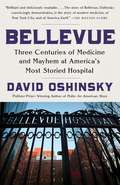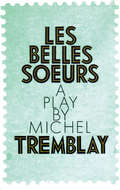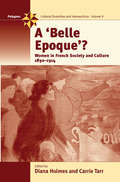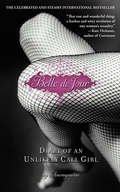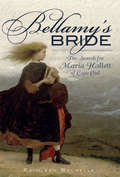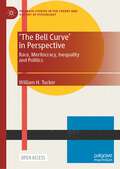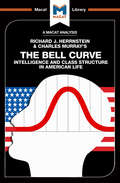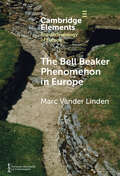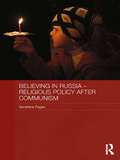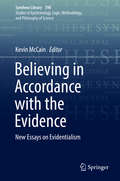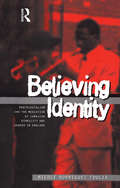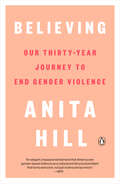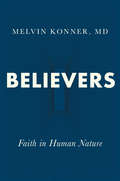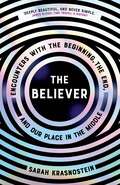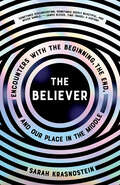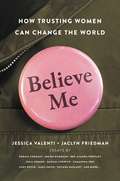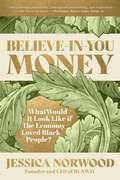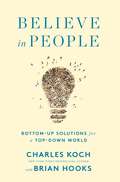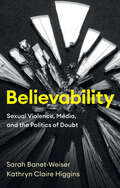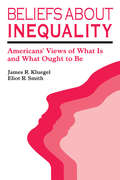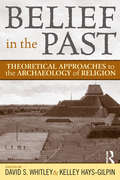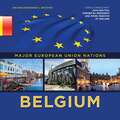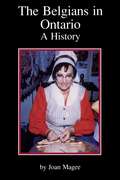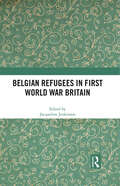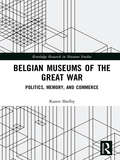- Table View
- List View
Bellevue: Three Centuries of Medicine and Mayhem at America's Most Storied Hospital
by David OshinskyFrom a Pulitzer Prize-winning historian comes a riveting history of New York's iconic public hospital that charts the turbulent rise of American medicine. Bellevue Hospital, on New York City's East Side, occupies a colorful and horrifying place in the public imagination: a den of mangled crime victims, vicious psychopaths, assorted derelicts, lunatics, and exotic-disease sufferers. In its two and a half centuries of service, there was hardly an epidemic or social catastrophe--or groundbreaking scientific advance--that did not touch Bellevue. David Oshinsky, whose last book, Polio: An American Story, was awarded a Pulitzer Prize, chronicles the history of America's oldest hospital and in so doing also charts the rise of New York to the nation's preeminent city, the path of American medicine from butchery and quackery to a professional and scientific endeavor, and the growth of a civic institution. From its origins in 1738 as an almshouse and pesthouse, Bellevue today is a revered public hospital bringing first-class care to anyone in need. With its diverse, ailing, and unprotesting patient population, the hospital was a natural laboratory for the nation's first clinical research. It treated tens of thousands of Civil War soldiers, launched the first civilian ambulance corps and the first nursing school for women, pioneered medical photography and psychiatric treatment, and spurred New York City to establish the country's first official Board of Health. As medical technology advanced, "voluntary" hospitals began to seek out patients willing to pay for their care. For charity cases, it was left to Bellevue to fill the void. The latter decades of the twentieth century brought rampant crime, drug addiction, and homelessness to the nation's struggling cities--problems that called a public hospital's very survival into question. It took the AIDS crisis to cement Bellevue's enduring place as New York's ultimate safety net, the iconic hospital of last resort. Lively, page-turning, fascinating, Bellevue is essential American history.
Belles Soeurs, Les
by Michel TremblayRaucous, reckless, and rude, the women of Les Belles Soeurs shamelessly share their most secret hopes and fears, complain stridently about their friends and relatives, and fantasize wistfully about escaping the misogynist drudgery of their lives. With the premiere of this play in 1968, Joual, the distinctive Québec vernacular, was legitimized, and Tremblay became "the father of the Québécois language."
A Belle Epoque?
by Diana Holmes Carrie tarrThe Third Republic, known as the 'belle époque', was a period of lively, articulate and surprisingly radical feminist activity in France, borne out of the contradiction between the Republican ideals of liberty, equality and fraternity and the reality of intense and systematic gender discrimination. Yet, it also was a period of intense and varied artistic production, with women disproving the critical nearconsensus that art was a masculine activity by writing, painting, performing, sculpting, and even displaying an interest in the new "seventh art" of cinema. This book explores all these facets of the period, weaving them into a complex, multi-stranded argument about the importance of this rich period of French women's history.
Belle de Jour: Diary of an Unlikely Call Girl
by AnonymousBelle couldn't find a job after University. Her impressive degree was not paying her rent or buying her food. But after a fantastic threesome with a very rich couple who gave her a ton of money, Belle realized that she could earn more than anyone she knew--by becoming a call girl. The rest is history. Belle became a 20-something London working girl--and had the audacity to write about it--anonymously. The shockingly candid and explicit diary she put on the Internet became a London sensation. She shares her entire journey inside the world of high-priced escorts, including fascinating and explicit insights about her job and her clients, her various boyfriends, and a taboo lifestyle that has to be read to be believed. The witty observations, shocking revelations, and hilarious scenarios deliver like the very best fiction and make for a titillating reading experience unlike any other.
Bellamy's Bride: The Search for Maria Hallett of Cape Cod (American Legends)
by Kathleen BrunelleAn intriguing exploration into the maritime legend of a young witch and an English pirate, “a love story layered in truth, wrapped in a mystery” (Cape Cod Travel Guide Blog).Venture back to 1715, when a fifteen-year-old Cape Cod girl named Maria Hallett was seduced by a twenty-six-year-old Englishman named Samuel Bellamy.Bellamy soon left her to become one of the most infamous pirates of his day—Black Sam Bellamy. Maria remained on the Cape but was forced to live in solitude after giving birth to Bellamy’s child. Two years later, Bellamy returned to his love, and Maria watched from the dunes as his flagship, the Whydah, sank in the worst nor’easter in the history of the Cape. The legend of Maria Hallett has been passed down for over two hundred years, and Cape Cod writer Kathleen Brunelle brings a fresh breath of sea air to this epic tale in her search for Bellamy’s bride.“Brunelle delves into vital records, previous versions of the story, history, genealogy, and mythology, attempting to determine what is truth and what is embellishment. Read this fascinating study and decide for yourself.” —You’re History!“Brunelle has been through numerous sources and uses text and antique drawings to explore how the relationship might have unfolded as Bellamy trolled the waters off Cape Cod and Maria waited on shore for his return.” —Cape Cod Times
'The Bell Curve' in Perspective: Race, Meritocracy, Inequality and Politics (Palgrave Studies in the Theory and History of Psychology)
by William H. TuckerThis open access book examines the implications of The Bell Curve for the social, economic, and political developments of the early 21st century. Following a review of the reception of The Bell Curve and its place in the campaign to end affirmative action, Professor Tucker analyses Herrnstein’s concept of the “meritocracy” in relation to earlier 20th century eugenics and the dramatic increase in economic inequality over the past 30 years. Tucker demonstrates how, contrary to The Bell Curve’s predictions, the reallocation of these huge sums was neither rational nor beneficial for society. The book moves on to situate The Bell Curve within contemporary politics and shows how it can be seen to have played a role in the 2016 US election. This compelling analysis will appeal to scholars and those with an interest in the history of scientific racism, the history of psychology and the sociology of knowledge and science.This is an open access book.
The Bell Curve: Intelligence and Class Structure in American Life
by Christine Ma Michael SchapiraHerrnstein & Murray's The Bell Curve is a deeply controversial text that raises serious issues about the stakes involved in reasoning and interpretation. The authors’ central contention is that intelligence is the primary factor determining social outcomes for individuals – and that it is a better predictor of achievement than income, background or socioeconomic status. One of the major issues raised by the book was its discussion of 'racial differences in intelligence,' and its contention that there is a link between the low observed test scores and social outcomes for African-Americans and their lack of social attainment. While the authors produce and interpret a great deal of data to back up their contentions, they ultimately fail to tackle the problem that neither 'intelligence' nor 'race' have widely accepted definitions in biology, anthropology or sociology. In consequence, the book it has been termed both ‘racist’ and ‘pseudoscientific’ thanks to what its critics see as both its faulty reasoning and its uncautious interpretation of evidence. The debate continues to this day, with academics on both sides engaged in fierce arguments over what can be argued from the data that Herrnstein and Murray used.
The Bell Beaker Phenomenon in Europe: A Harmony of Difference (Elements in the Archaeology of Europe)
by null Marc Vander LindenCovering vast swathes of Europe, the Bell Beaker Phenomenon has enjoyed a privileged status in the history of archaeology and is often referred to as a key period in the transition from the Neolithic to the Bronze Age partly due to the emergence of social élites. After a brief presentation of the historiography of the Bell Beaker phenomenon, this Element offers a synthetic account of the available evidence structured on a regional basis. Following the renewed interest in human mobility generated by stable isotopes and ancient DNA studies, the central thesis developed here is that the Bell Beaker Phenomenon can adequately be described as a metapopulation, a concept borrowed from population ecology. This title is also available as Open Access on Cambridge Core.
Believing in Russia - Religious Policy after Communism: Religious Policy After Communism (Routledge Contemporary Russia and Eastern Europe Series)
by Geraldine FaganThis book presents a comprehensive overview of religious policy in Russia since the end of the communist regime, exposing many of the ambiguities and uncertainties about the position of religion in Russian life. It reveals how religious freedom in Russia has, contrary to the widely held view, a long tradition, and how the leading religious institutions in Russia today, including especially the Russian Orthodox Church but also Muslim, Jewish and Buddhist establishments, owe a great deal of their special positions to the relationship they had with the former Soviet regime. It examines the resurgence of religious freedom in the years immediately after the end of the Soviet Union, showing how this was subsequently curtailed, but only partially, by the important law of 1997. It discusses the pursuit of privilege for the Russian Orthodox Church and other ‘traditional’ beliefs under presidents Putin and Medvedev, and assesses how far Russian Orthodox Christianity is related to Russian national culture, demonstrating the unresolved nature of the key question, ‘Is Russia to be an Orthodox country with religious minorities or a multi-confessional state?’ It concludes that Russian society’s continuing failure to reach a consensus on the role of religion in public life is destabilising the nation.
Believing in Accordance with the Evidence: New Essays on Evidentialism (Synthese Library #398)
by Kevin McCainThis volume explores evidentialism, a major theory of epistemic justification. It contains more than 20 papers that examine its nuances, its challenges, as well as its future directions. Written by leading and up-and-coming epistemologists, the papers cover a wide array of topics related to evidentialism. The contributors present both sides of the theory: some are advocates of evidentialism, while others are critics. This provides readers with a comprehensive, and cutting-edge, understanding of this epistemic theory. Overall, the book is organized into six parts: The Nature of Evidence, Understanding Evidentialism, Problems for Evidentialism, Evidentialism and Social Epistemology, New Directions for Evidentialism, and Explanationist Evidentialism. Readers will find insightful discussion on such issues as the ontology of evidence, phenomenal dogmatism, how experiences yield evidence, the new evil demon problem, probability, norms of credibility, intellectual virtues, wisdom, epistemic justification, and more. This title provides authoritative coverage of evidentialism, from the latest developments to the most recent philosophical criticisms. It will appeal to researchers and graduate students searching for more information on this prominent epistemological theory.
Believing Identity: Pentecostalism and the Mediation of Jamaican Ethnicity and Gender in England
by Nicole ToulisThe complex and sometimes contradictory articulation of ethnicity, religion and gender informs this book on the cultural construction of identity for Jamaican migrants in Britain. The author argues that religion -- in this case Pentecostalism -- cannot be understood simply as a means of spiritual compensation for the economically disadvantaged. Rather, in the New Testament Church of God, one of Britain's largest African Caribbean churches, the cosmology of the church resolves the questions surrounding identity as well as suffering. Religious participation is one way in which African Caribbean people negotiate the terms of representation and interaction in British society.
Believing: Our Thirty-Year Journey to End Gender Violence
by Anita HillFrom the woman who gave the landmark testimony against Clarence Thomas as a sexual menace, a new manifesto about the origins and course of gender violence in our society; a combination of memoir, personal accounts, law, and social analysis, and a powerful call to arms from one of our most prominent and poised survivors. <p><p> In 1991, Anita Hill began something that's still unfinished work. The issues of gender violence, touching on sex, race, age, and power, are as urgent today as they were when she first testified. Believing is a story of America's three decades long reckoning with gender violence, one that offers insights into its roots, and paths to creating dialogue and substantive change. It is a call to action that offers guidance based on what this brave, committed fighter has learned from a lifetime of advocacy and her search for solutions to a problem that is still tearing America apart. <p><p> We once thought gender-based violence--from casual harassment to rape and murder--was an individual problem that affected a few; we now know it's cultural and endemic, and happens to our acquaintances, colleagues, friends and family members, and it can be physical, emotional and verbal. Women of color experience sexual harassment at higher rates than White women. Street harassment is ubiquitous and can escalate to violence. Transgender and nonbinary people are particularly vulnerable. Anita Hill draws on her years as a teacher, legal scholar, and advocate, and on the experiences of the thousands of individuals who have told her their stories, to trace the pipeline of behavior that follows individuals from place to place: from home to school to work and back home. In measured, clear, blunt terms, she demonstrates the impact it has on every aspect of our lives, including our physical and mental wellbeing, housing stability, political participation, economy and community safety, and how our descriptive language undermines progress toward solutions. And she is uncompromising in her demands that our laws and our leaders must address the issue concretely and immediately.
Believers: Faith And Human Nature
by Melvin KonnerAn anthropologist examines the nature of religiosity, and how it shapes and benefits humankind. Believers is a scientist’s answer to attacks on faith by some well-meaning scientists and philosophers. It is a firm rebuke of the “Four Horsemen”—Richard Dawkins, Daniel Dennett, Sam Harris, and Christopher Hitchens—known for writing about religion as something irrational and ultimately harmful. Anthropologist Melvin Konner, who was raised as an Orthodox Jew but has lived his adult life without such faith, explores the psychology, development, brain science, evolution, and even genetics of the varied religious impulses we experience as a species. Conceding that faith is not for everyone, he views religious people with a sympathetic eye; his own upbringing, his apprenticeship in the trance-dance religion of the African Bushmen, and his friends and explorations in Christian, Buddhist, Hindu, Muslim, and other faiths have all shaped his perspective. Faith has always manifested itself in different ways—some revelatory and comforting; some kind and good; some ecumenical and cosmopolitan; some bigoted, coercive, and violent. But the future, Konner argues, will both produce more nonbelievers, and incline the religious among us—holding their own by having larger families—to increasingly reject prejudice and aggression. A colorful weave of personal stories of religious—and irreligious—encounters, as well as new scientific research, Believers shows us that religion does much good as well as undoubted harm, and that for at least a large minority of humanity, the belief in things unseen neither can nor should go away.
The Believer: Encounters with the Beginning, the End, and our Place in the Middle
by Sarah KrasnosteinAn unforgettable tour of the human condition that explores our universal need for belief to help us make sense of life, death, and everything in between. <p><p> For Sarah Krasnostein it begins with a Mennonite choir performing on a subway platform, a fleeting moment of witness that sets her on a fascinating journey to discover why people need to believe in absolute truths and what happens when their beliefs crash into her own. Some of the people Krasnostein interviews believe in things many people do not: ghosts, UFOs, the literal creation of the universe in six days. Some believe in things most people would like to: dying with dignity and autonomy; facing up to our transgressions with truthfulness; living with integrity and compassion. <p><p> By turns devastating and uplifting, and captured in snapshot-vivid detail, these six profiles of a death doula, a geologist who believes the world is six thousand years old, a lecturer in neurobiology who spends his weekends ghost hunting, the fiancée of a disappeared pilot and UFO enthusiasts, a woman incarcerated for killing her husband after suffering years of domestic violence, and Mennonite families in New York will leave you convinced that the most ordinary-seeming people are often the most remarkable and that deep and abiding commonalities can be found within the greatest differences. <p><p> Vivid, unconventional, entertaining, and full of wonder, The Believer interweaves these stories with compassion and empathy, culminating in an unforgettable tour of the human condition that cuts to the core of who we are as people, and what we’re doing on this earth.
The Believer: Encounters with the Beginning, the End, and Our Place in the Middle
by Sarah Krasnostein“Deeply beautiful, and never simple.” — James Gleick, author of Time Travel: A History An unforgettable tour of the human condition that explores our universal need for belief to help us make sense of life, death, and everything in between. For Sarah Krasnostein it begins with a Mennonite choir on a subway platform, a fleeting moment of witness that sets her on a fascinating journey to discover why people need to believe in absolute truths and what happens when their beliefs crash into her own. Some of the people Krasnostein interviews believe in things many people do not: ghosts, UFOs, the literal creation of the universe in six days. Some believe in things most people would like to: dying with dignity and autonomy; facing up to our transgressions with truthfulness; living with integrity and compassion. By turns devastating and uplifting, and captured in snapshot-vivid detail, these six profiles — a death doula, a geologist who believes the world is six thousand years old, a lecturer in neurobiology who spends his weekends ghost hunting, the fiancé of a disappeared pilot and UFO enthusiasts, a woman incarcerated for killing her husband after suffering years of domestic violence, and Mennonite families in New York — will leave you convinced that the most ordinary-seeming people are often the most remarkable and that deep and abiding commonalities can be found within the greatest differences. Vivid, unconventional, entertaining, and full of wonder, The Believer interweaves these stories with compassion and empathy, culminating in an unforgettable tour of the human condition that cuts to the core of who we are as people, and what we’re doing on this earth.
Believe Me: How Trusting Women Can Change the World
by Jessica Valenti Jaclyn Friedmanp.p1 {margin: 0.0px 0.0px 10.0px 0.0px; font: 12.0px 'Times New Roman'} p.p2 {margin: 0.0px 0.0px 0.0px 0.0px; font: 11.0px 'Times New Roman'} p.p3 {margin: 0.0px 0.0px 0.0px 0.0px; font: 11.0px 'Times New Roman'; min-height: 12.0px} p.p4 {margin: 0.0px 0.0px 0.0px 0.0px; font: 12.0px 'Times New Roman'; min-height: 15.0px} What would happen if we believed women? A groundbreaking anthology offers a potent rallying cry and theory of changeHarvey Weinstein. Brett Kavanaugh. Jeffrey Epstein. Donald Trump. The most infamous abusers in modern American history are being outed as women speak up to publicly expose behavior that was previously only whispered about -- and it's both making an impact, and sparking a backlash. From the leading, agenda-setting feminist editors of Yes Means Yes, Believe Me brings readers into the evolving landscape of the movement against sexual violence, and outlines how trusting women is the critical foundation for future progress. In Believe Me, contributors ask and answer the crucial question: What would happen if we didn't just believe women, but acted as though they matter? If we take women's experiences of online harassment seriously, it will transform the internet. If we listen to and center survivors, we could revolutionize our systems of justice. If we believe Black women when they talk about pain, we will save countless lives. With contributions from many of the most important voices in feminism today, Believe Me is an essential roadmap for the #MeToo era and beyond.
Believe-in-You Money: What Would It Look Like If the Economy Loved Black People?
by Jessica NorwoodOffering a revolution in Black business financing, this book centers the entrepreneur and responds to the systemic failures surrounding Black wealth building.America has a huge racial wealth gap today. Owning a business is one of the best ways to build wealth-but entrepreneurs need capital. And investing in Black companies is obstructed by systemic racism and implicit biases that continue to create barriers to success. Merging historical information and data with tactical examples and explanations, this practical guide shows us what needs to be done to change the way we support Black companies and how we think about wealth.Norwood calls for investors to move away from extractive, individualistic, and exploitative approaches to capital and entrepreneurship. She asks us to move toward transformational, restorative, regenerative, and interdependent relationships to repair the impacts of systemic racism. Investors, large and small, need to say to Black business owners, We believe in you.With an entrepreneur-centric approach, Believe-in-You Money challenges the systemic failure surrounding Black companies. This book is a guide on how Black entrepreneurs can be supported in sustainable ways and offers a shift in the way we think about who can be an investor while also aiming to change our personal relationships with money.
Believe in People: Bottom-Up Solutions for a Top-Down World
by Charles Koch Brian HooksA surprising take on how you can help tackle the really big problems in society–from one of America’s most successful entrepreneurs.People are looking for a better way. Towering barriers are holding millions of people back, and the institutions that should help everyone rise are not doing the job. Crumbling communities. One-size fits all education. Businesses that rig the economy. Public policy that stifles opportunity and emboldens the extremes. As a result, this country is quickly heading toward a two-tiered society.Today’s challenges call for nothing short of a paradigm shift – away from a top-down approach that sees people as problems to be managed, toward bottom-up solutions that empower everyone to realize their potential and foster a more inclusive society.Such a shift starts by asking: What would it mean to truly believe in people?Businessman and philanthropist Charles Koch has devoted his life to answering that question. Learn what he’s discovered during his 60-year career to help you apply the principles of empowerment in your life, in your business, and in society.By learning from the social movements and applying the principles that have enabled social progress throughout history, Koch has achieved more than he dreamed possible – building one of the world’s most successful companies and founding Stand Together, one of America’s most innovative philanthropic communities. Stand Together CEO Brian Hooks and Koch show how the only way to solve the really big problems – from poverty and addiction to harmful business practices and destructive public policy – is for each and every one of us to find and take action in our unique role as part of the solution.Full of compelling examples of what works – including several first-person accounts from individuals whose lives have been transformed – Koch and Hooks’ refreshing approach promotes partnership instead of partisanship and speaks to people from different perspectives and all walks of life. They show that no injustice is too tough to overcome if you share a deep belief in people, are willing to unite with anyone to do right, and work to empower others from the bottom up.
Believability: Sexual Violence, Media, and the Politics of Doubt
by Sarah Banet-Weiser Kathryn Claire HigginsThe #MeToo movement has created more opportunities for women to speak up about sexual assault and harassment. But we are also living in a time when “fake news” and “alternative facts” call into question the very nature of truth. For questions about sexual violence, who do we believe and why? And how do the answers change when the very idea of “truth” is in question?This troubling paradox is at the heart of this book. The convergence of the #MeToo movement and the crisis of post-truth is used to explore the experiences of women and people of color whose credibility around issues of sexual violence is often in doubt. Offering a feminist re-thinking of “post-truth”, Banet-Weiser and Higgins shift the lens from truth to “believability” to investigate how the gendered and racialized logics of this concept are defined and contested within media culture. Drawing on analysis of a wide variety of media texts and products including film, news articles, social media campaigns, and wearable technologies, the authors propose that an “economy of believability’” is a necessary framework for understanding the context in which public bids for truth about sexual violence are made, negotiated, and authorized. Believability interrogates this economy as one in which powerful white men have historically wielded disproportionate influence – so, an economy which is deeply structured by gender and race.Timely and compelling, this book makes a provocative intervention into scholarly and popular debates about the character of believability when women speak up about sexual assault. It will appeal to scholars and students across the social sciences and humanities as well as general readers.
Beliefs about Inequality: Americans' Views of What is and What Ought to be
by James R. Kluegel Eliot R. SmithMotivated by the desire to explain how Americans perceive and evaluate inequality and related programs and policies, the authors conducted a national survey of beliefs about social and economic inequality in America. Here they present the results of their research on the structure, determinants, and certain political and personal consequences of these beliefs. The presentations serve two major goals; to describe and explain the central features of Americans' images of inequality. Beliefs About Inequality begins with a focus on people's perceptions of the most basic elements of inequality: the availability of opportunity in society, the causes of economic achievements, and the benefits and costs of equality and inequality. The book's analysis of the public's beliefs on these key issues is based on fundamental theories of social psychology and lays the groundwork for understanding how Americans evaluate inequality-related policies. The authors discuss the ultimate determinants of beliefs and the implications of their findings for social policies related to inequality. They propose that attitudes toward economic inequality and related policy are influenced by three major aspects of the current American social, economic, and political environment: a stable "dominant ideology" about economic inequality; individuals' social and economic status; and specific beliefs and attitudes, often reflecting "social liberalism" shaped by recent political debates and events.
Belief in the Past: Theoretical Approaches to the Archaeology of Religion
by David S. Whitley Kelley Hays-GilpinHuman actions are often deeply intertwined with religion and can be understood in a strictly religious context. Yet, many volumes and articles pertaining to discussions of religion in the archaeological past have focused primarily on the sociopolitical implications of such remains. The authors in this volume argue that while these interpretations certainly have a meaningful place in understanding the human past, they provide only part of the picture. Because strictly religious contexts have often been ignored, this has resulted in an incomplete assessment of religious behavior in the past. This volume considers exciting new directions for considering an archaeology of religion, offering examples from theory, tangible archaeological remains, and ethnography.
Belgium (Major European Union Nations)
by Ida WalkerAlthough Belgium is a small country, it is a big player in Europe. It was a founding member of the EU back in 1952. Today, Brussels, its capital city, is one of the EU's centers. Despite being divided between French and Dutch speakers, Belgium is a strong country with a lot going on culturally and politically. Discover more about this exciting, modern nation!
The Belgians in Ontario: A History
by Joan MageeThe Belgians in Ontario chronicles more than 300 years of Belgian presence in Ontario, beginning with Father Louis Hennepin, the Recollet missionary who accompanied La Salle on his explorations. This book examines the contributions of the Belgian community in a diverse range of activities including agriculture, sports, and the arts. Magee offers a detailed analysis of reasons and methods of immigration (including a study of the pioneering agricultural labourers who participated in the swallow migration). Of special interest to students of social and ethnic studies is the extensive survey of Belgian Canadians, reflecting their attitudes and experiences. Lavishly illustrated with more than 50 rare photographs culled from private and public collections, The Belgians in Ontario is a visually-interesting look at the many contributions of a determined people.
Belgian Refugees in First World War Britain
by Jacqueline JenkinsonAround 250,000 Belgian refugees who fled the German invasion spent the First World War in Britain – the largest refugee presence Britain has ever witnessed. Welcomed in a wave of humanitarian sympathy for ‘Poor Little Belgium’, within a few months Belgian exiles were pushed off the front pages of newspapers by the news of direct British involvement in the war. Following rapid repatriation at British government expense in late 1918 and 1919 Belgian refugees were soon lost from public memory with few memorials or markers of their mass presence.Reactions to Belgian refugees discussed in this book include the mixed responses of local populations to the refugee presence, which ranged from extensive charitable efforts to public and trade union protests aimed at protecting local jobs and housing. This book also explores the roles of central and local government agencies which supported and employed Belgian refugees en masse yet also used them as a propaganda tool to publicise German outrages against civilians to encourage support for the Allied war effort. This book covers responses to Belgian refugees in England, Scotland, Ireland and Wales in a Home Front wartime episode which generated intense public interest and charitable and government action. This book was originally published as a special issue of Immigrants and Minorities: Historical Studies in Ethnicity, Migration and Diaspora.
Belgian Museums of the Great War: Politics, Memory, and Commerce (Routledge Research in Museum Studies)
by Karen ShelbyBelgian Museums of the Great War: Politics, Memory, and Commerce examines the handling of the centennial of World War I by several museums along the Western Front in Flanders, Belgium. In the twenty-first century, the museum has become a strategic space for negotiating ownership of and access to knowledge produced in local settings. The specific focus on museums and commemorative events in Flanders allows for an in-depth evaluation of how each museum works with the remembrance and tourist industry in the region while carving a unique niche. Belgian Museums of the Great War writes the history of these institutions, analyzes the changes made in advance of the anniversary years, and considers the site-specificity of each institution and its architectural frame. Since museums not only transmit information but also shape knowledge, as Eileen Hooper-Greenhill has noted, the diverse narratives and community programs sponsored by each museum have served to challenge prior historiographies of the war. Through newly revamped interactive environments, self-guided learning, and an emphasis on the landscape, the museums in Flanders have a significant role to play in the ever-changing dialogue on the meaning of the history and remembrance of the Great War.
